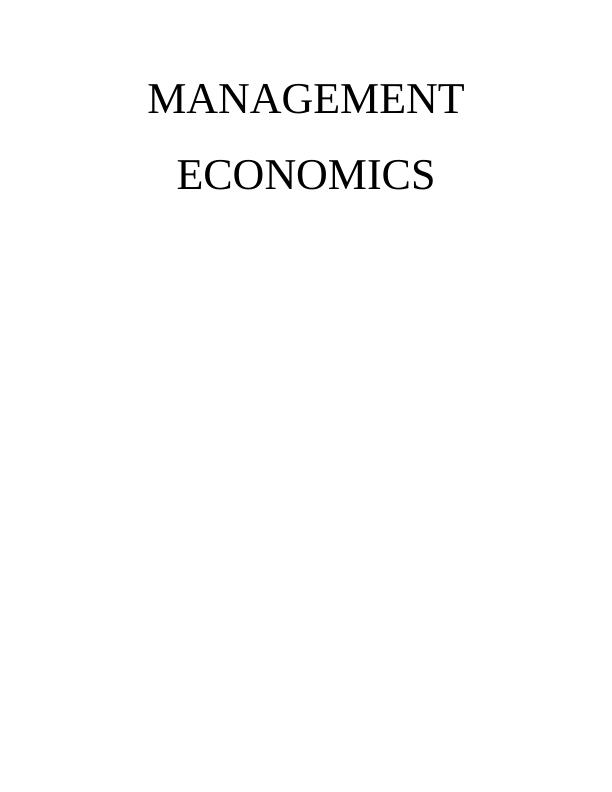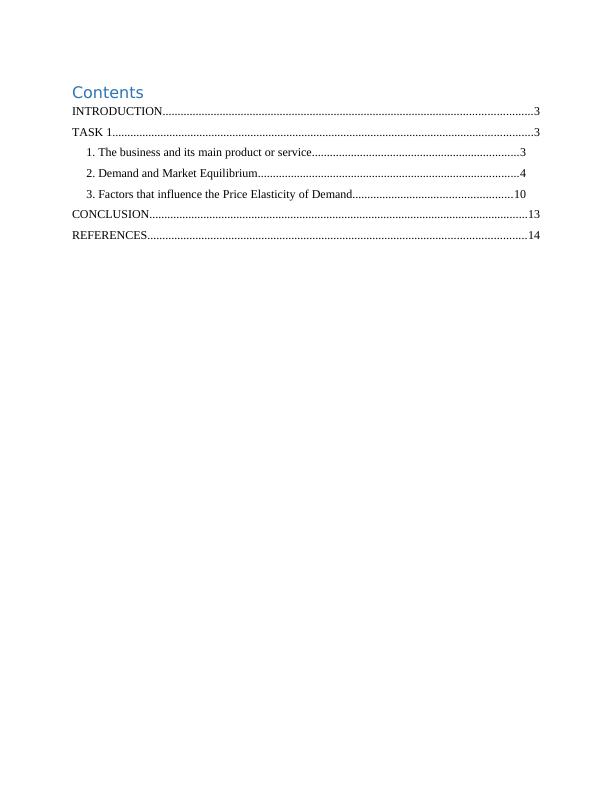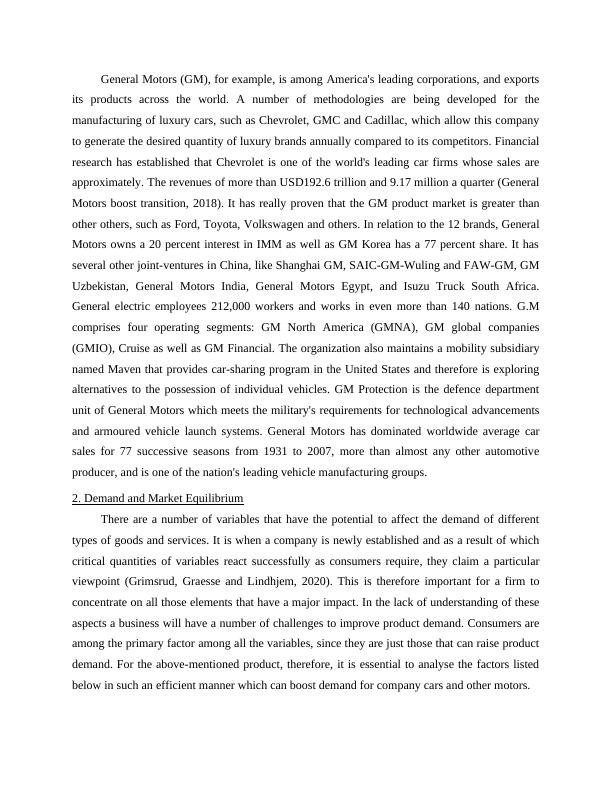Management Economics: Demand and Market Equilibrium
Added on 2023-01-07
14 Pages3486 Words40 Views
MANAGEMENT
ECONOMICS
ECONOMICS

Contents
INTRODUCTION...........................................................................................................................3
TASK 1............................................................................................................................................3
1. The business and its main product or service.....................................................................3
2. Demand and Market Equilibrium.......................................................................................4
3. Factors that influence the Price Elasticity of Demand.....................................................10
CONCLUSION..............................................................................................................................13
REFERENCES..............................................................................................................................14
INTRODUCTION...........................................................................................................................3
TASK 1............................................................................................................................................3
1. The business and its main product or service.....................................................................3
2. Demand and Market Equilibrium.......................................................................................4
3. Factors that influence the Price Elasticity of Demand.....................................................10
CONCLUSION..............................................................................................................................13
REFERENCES..............................................................................................................................14

INTRODUCTION
Management economics is defines as the market strategy theory that encourages major
elements like income and spending, money, etc. to be efficient in combination. In addition,
management in a company uses this concept to tackle such business-related problems and
requires a range of key concepts and decision-making strategies (Teece, 2019). In general term it
is among the main principle which distinguishes different economic perspectives as a
comparison between market strategies for strategic decision making. These options are directed
towards cost savings and increasing efficiency by efficient businesses and productions.
The report will concentrate on how firms use the market economy theory to explain their
recent actions and to forecast future company performance. In the study, General Motors is
chosen which deals in car industry because it is cantered in several countries, where the supply
of raw materials as well as market changes has a significant impact on the growth of the vehicle.
In this study, various variables that aim to assess if the competition for GM products is elastic or
inelastic are evaluated to examine this subject.
TASK 1
1. The business and its main product or service.
The automotive industry is a highly developed sector which is increasingly growing its
global market. Companies in various nations involved in the manufacture and sale of millions of
cars, buses as well as other vehicles each year (Sfeir-Younis, 2019). By turn, this would help
expand the economies of a nation and contribute to the overt or tacit development of jobs for
millions of people. In fact, the automobile industry also bears responsibility for the use of
petroleum or oil. Therefore, in studying the theory of managerial economics, the chosen
automotive area is more useful, because it analyses entire issues that are important to their
analysis.
Management economics is defines as the market strategy theory that encourages major
elements like income and spending, money, etc. to be efficient in combination. In addition,
management in a company uses this concept to tackle such business-related problems and
requires a range of key concepts and decision-making strategies (Teece, 2019). In general term it
is among the main principle which distinguishes different economic perspectives as a
comparison between market strategies for strategic decision making. These options are directed
towards cost savings and increasing efficiency by efficient businesses and productions.
The report will concentrate on how firms use the market economy theory to explain their
recent actions and to forecast future company performance. In the study, General Motors is
chosen which deals in car industry because it is cantered in several countries, where the supply
of raw materials as well as market changes has a significant impact on the growth of the vehicle.
In this study, various variables that aim to assess if the competition for GM products is elastic or
inelastic are evaluated to examine this subject.
TASK 1
1. The business and its main product or service.
The automotive industry is a highly developed sector which is increasingly growing its
global market. Companies in various nations involved in the manufacture and sale of millions of
cars, buses as well as other vehicles each year (Sfeir-Younis, 2019). By turn, this would help
expand the economies of a nation and contribute to the overt or tacit development of jobs for
millions of people. In fact, the automobile industry also bears responsibility for the use of
petroleum or oil. Therefore, in studying the theory of managerial economics, the chosen
automotive area is more useful, because it analyses entire issues that are important to their
analysis.

General Motors (GM), for example, is among America's leading corporations, and exports
its products across the world. A number of methodologies are being developed for the
manufacturing of luxury cars, such as Chevrolet, GMC and Cadillac, which allow this company
to generate the desired quantity of luxury brands annually compared to its competitors. Financial
research has established that Chevrolet is one of the world's leading car firms whose sales are
approximately. The revenues of more than USD192.6 trillion and 9.17 million a quarter (General
Motors boost transition, 2018). It has really proven that the GM product market is greater than
other others, such as Ford, Toyota, Volkswagen and others. In relation to the 12 brands, General
Motors owns a 20 percent interest in IMM as well as GM Korea has a 77 percent share. It has
several other joint-ventures in China, like Shanghai GM, SAIC-GM-Wuling and FAW-GM, GM
Uzbekistan, General Motors India, General Motors Egypt, and Isuzu Truck South Africa.
General electric employees 212,000 workers and works in even more than 140 nations. G.M
comprises four operating segments: GM North America (GMNA), GM global companies
(GMIO), Cruise as well as GM Financial. The organization also maintains a mobility subsidiary
named Maven that provides car-sharing program in the United States and therefore is exploring
alternatives to the possession of individual vehicles. GM Protection is the defence department
unit of General Motors which meets the military's requirements for technological advancements
and armoured vehicle launch systems. General Motors has dominated worldwide average car
sales for 77 successive seasons from 1931 to 2007, more than almost any other automotive
producer, and is one of the nation's leading vehicle manufacturing groups.
2. Demand and Market Equilibrium
There are a number of variables that have the potential to affect the demand of different
types of goods and services. It is when a company is newly established and as a result of which
critical quantities of variables react successfully as consumers require, they claim a particular
viewpoint (Grimsrud, Graesse and Lindhjem, 2020). This is therefore important for a firm to
concentrate on all those elements that have a major impact. In the lack of understanding of these
aspects a business will have a number of challenges to improve product demand. Consumers are
among the primary factor among all the variables, since they are just those that can raise product
demand. For the above-mentioned product, therefore, it is essential to analyse the factors listed
below in such an efficient manner which can boost demand for company cars and other motors.
its products across the world. A number of methodologies are being developed for the
manufacturing of luxury cars, such as Chevrolet, GMC and Cadillac, which allow this company
to generate the desired quantity of luxury brands annually compared to its competitors. Financial
research has established that Chevrolet is one of the world's leading car firms whose sales are
approximately. The revenues of more than USD192.6 trillion and 9.17 million a quarter (General
Motors boost transition, 2018). It has really proven that the GM product market is greater than
other others, such as Ford, Toyota, Volkswagen and others. In relation to the 12 brands, General
Motors owns a 20 percent interest in IMM as well as GM Korea has a 77 percent share. It has
several other joint-ventures in China, like Shanghai GM, SAIC-GM-Wuling and FAW-GM, GM
Uzbekistan, General Motors India, General Motors Egypt, and Isuzu Truck South Africa.
General electric employees 212,000 workers and works in even more than 140 nations. G.M
comprises four operating segments: GM North America (GMNA), GM global companies
(GMIO), Cruise as well as GM Financial. The organization also maintains a mobility subsidiary
named Maven that provides car-sharing program in the United States and therefore is exploring
alternatives to the possession of individual vehicles. GM Protection is the defence department
unit of General Motors which meets the military's requirements for technological advancements
and armoured vehicle launch systems. General Motors has dominated worldwide average car
sales for 77 successive seasons from 1931 to 2007, more than almost any other automotive
producer, and is one of the nation's leading vehicle manufacturing groups.
2. Demand and Market Equilibrium
There are a number of variables that have the potential to affect the demand of different
types of goods and services. It is when a company is newly established and as a result of which
critical quantities of variables react successfully as consumers require, they claim a particular
viewpoint (Grimsrud, Graesse and Lindhjem, 2020). This is therefore important for a firm to
concentrate on all those elements that have a major impact. In the lack of understanding of these
aspects a business will have a number of challenges to improve product demand. Consumers are
among the primary factor among all the variables, since they are just those that can raise product
demand. For the above-mentioned product, therefore, it is essential to analyse the factors listed
below in such an efficient manner which can boost demand for company cars and other motors.

End of preview
Want to access all the pages? Upload your documents or become a member.
Related Documents
Management Economics: Factors Influencing Demand for General Motorslg...
|15
|3068
|64
Management Economics: Factors Influencing Demand of General Motors Carslg...
|12
|2508
|92
Management Economics: Factors Influencing Demand for General Motorslg...
|15
|3272
|94
Market Analysis of General Motorslg...
|11
|3120
|94
Management Economics Assessment 1lg...
|11
|3042
|476
Market Analysis of General Motors (GM) in the Automotive Industrylg...
|11
|3048
|26